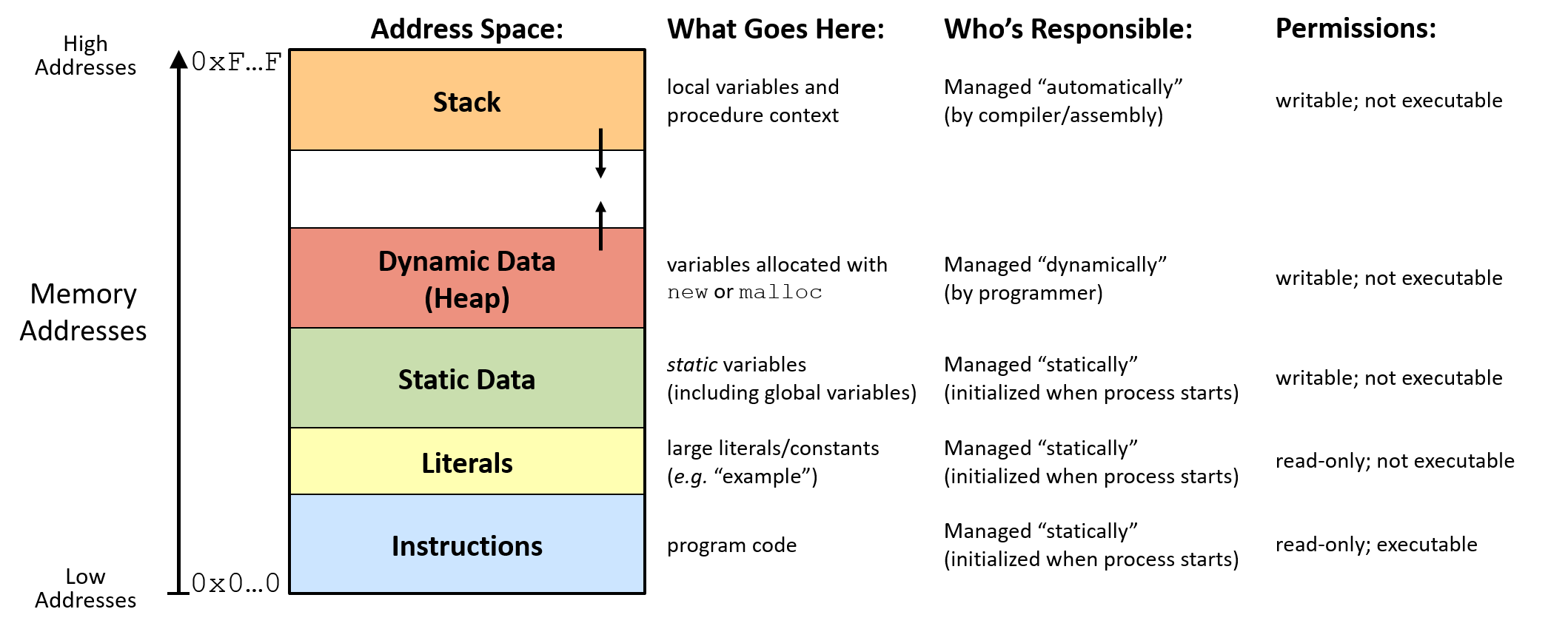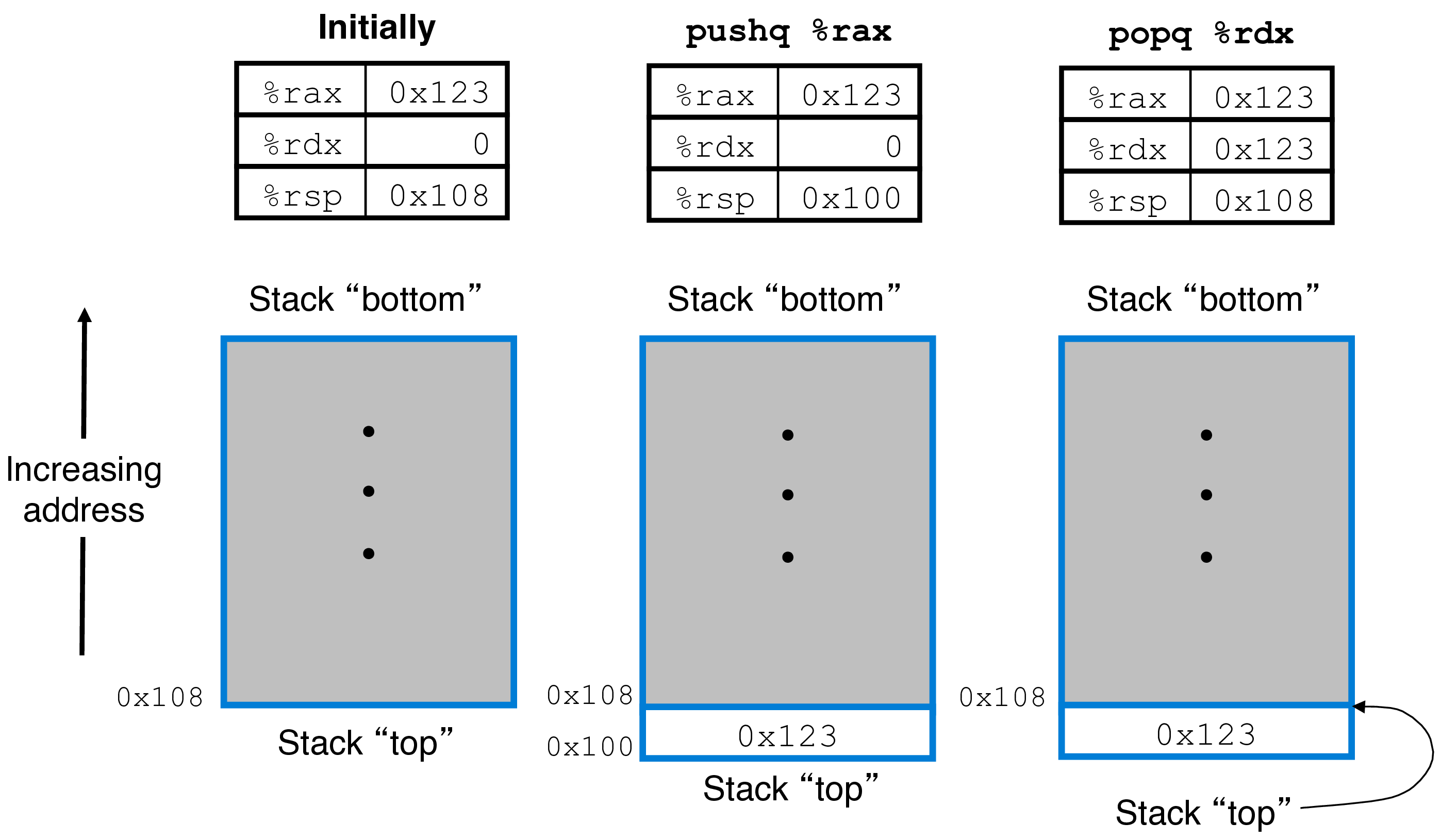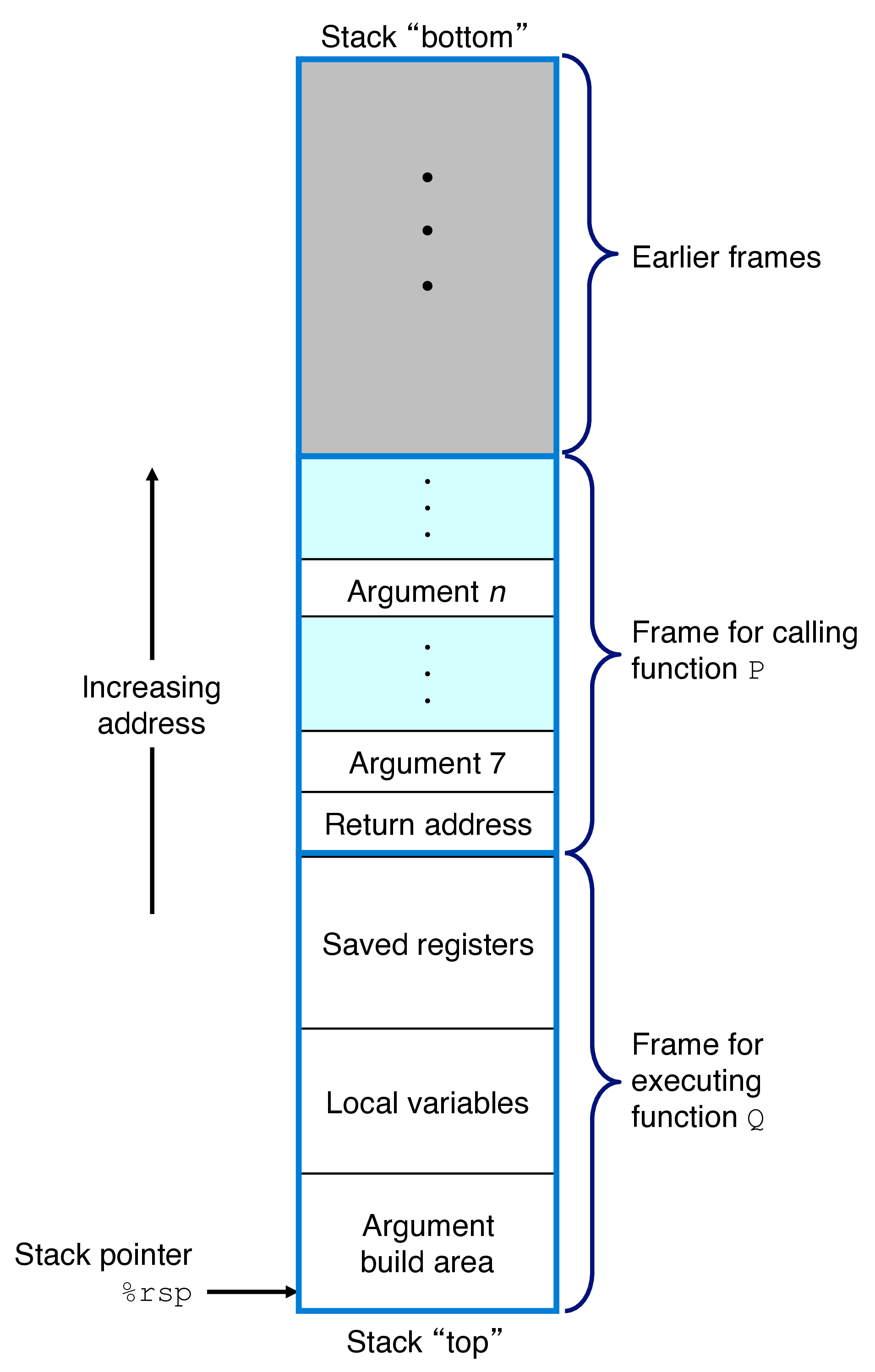CS 208 s20 — Memory Layout and the Stack
Table of Contents
1 Video
Here is a video lecture for the material outlined below. It covers CSPP sections 3.4.4 and 3.7 (through 3.7.2) (p. 189–191, 238–244). It contains sections on
- memory layout review (0:00)
- push and pop instructions (4:00)
- pop instruction quick check (13:22)
- Can we do procedure calls with jmp? (15:48)
- Procedure call requirements (19:45)
- call and ret instructions (33:11)
- example in gdb (38:30)
- end notes (43:35)
The Panopto viewer has table of contents entries for these sections. Link to the Panopto viewer: https://carleton.hosted.panopto.com/Panopto/Pages/Viewer.aspx?id=6f10dd31-b406-4f9d-a758-abb300ff0c1c
2 Stack Operations

pushqandpopqinstructions push/pop quad words onto/off of the program stackpushqhas a source operand,popqhas a destination- the stack is a region of memory used to facilitate local variables and procedure calls
- top of the stack is the lowest memory address, and is conventionally drawn at the bottom
- each of these instructions combine a data move (copy the source to memory location for
push, copy value in memory to destination forpop) and modifying the stack pointer%rsp, the stack pointer, always contains the address of the top of the stack- either decremented by 8 (
push, stack grows down) or incremented by 8 (pop)

2.1 Quick Check
Top of the stack at 0x200, 8 bytes stored there contain 0x20. What changes about registers or memory as a result of popq %r8?1
3 Procedures
3.1 Are Jumps Enough?
- could we implement procedure calls using jumps?
- maybe we could use
jmpto go into a function call, and then return byjmp-ing to a label right after the call
func1: ... jmp func2 back: ... done: func2: ... jmp back done:
- but what if
func1callsfunc2twice?
func1: ... jmp func2 back1: ... jmp func2 back2: ... done: func2: ... jmp back? // which label do we jump to?? Have to choose at compile time done:
- we would need to compile a different version of
func2for every call, so that we could jump back to the right place - there's got to be a better way…
3.2 Overview
- mechanisms needed to facilitate procedures (e.g., procedure
Pcalls procedureQ, thenQexecutes and returns back toP):- passing control: instruction pointer (
%rip) must be set to the start ofQ(call) and then set to the instruction following the call toQinP(return) - passing data:
Phas to provide arguments toQandQhas to return a value toP - allocating and deallocating memeory:
Qneeds to acquire space for local variables and then free that space
- passing control: instruction pointer (
- requires seperate storage per call (not just per procedure)
3.3 The Run-Time Stack

- a stack data structure (last-in, first-out) a natural fit for managing run-time procedure memory
- only the most recent procedure call needs to allocate space for local variables or make a new procedure call
- when a procedure returns, we want to free the memory used by this most recent call
- hence it's a natural fit to push and pop procedure data from a stack
- when a procedure allocates space on the stack it is called that procedure's stack frame
- x86-64 only allocates what a procedure actually needs
- if a procedure's local variables can all be held in registers and it calls no other procedures, no stack frame is needed
3.4 Control Transfer
- processor needs to know where it should resume execution after a procedure call returns
- the
callinstruction pushes the return address of the following instruction onto the stack (part of the calling procedure's stack frame) and sets the instruction pointer (%rip)to the start of the new procedurecalloperand can either be direct (a label) or indirect (*followed by one of the standard operand formats)
- the
retinstruction pops the return address off the stack and copies it to%rip
- the
3.4.1 Example in gdb
#include <stdio.h> #define MAX_INPUT_LEN 100 long square(long x) { return x * x; } int main() { char input[MAX_INPUT_LEN]; printf("enter a number: "); fgets(input, MAX_INPUT_LEN, stdin); // read from the command line, store as a string in input long num; sscanf(input, "%ld", &num); // parse input as a long, store in num printf("your number squared is %ld\n", square(num)); }
4 Homework
- CSPP practice problem 3.32 (p. 244)
- Work on lab 2. Post in the lab 2 check-in forum. Your post should be something surprising or difficult that you've learned that you think would help others, a point of confusion, something you're stuck on, a deeper question sparked by the lab, or a response to someone else's post.
Footnotes:
popq copies the top 8 bytes of the stack to %r8, so %r8 will now contain 0x20.
This also "pops" these 8 bytes off the stack, so 8 is added to %rsp, making it 0x208 (remember, the stack grows down to lower memory addresses, so moving %rsp up in memory shrinks the stack).
Nothing changes in terms of values stored in memory---%rsp tracks the top of the stack, but the system doesn't zero-out popped values or anything like that.